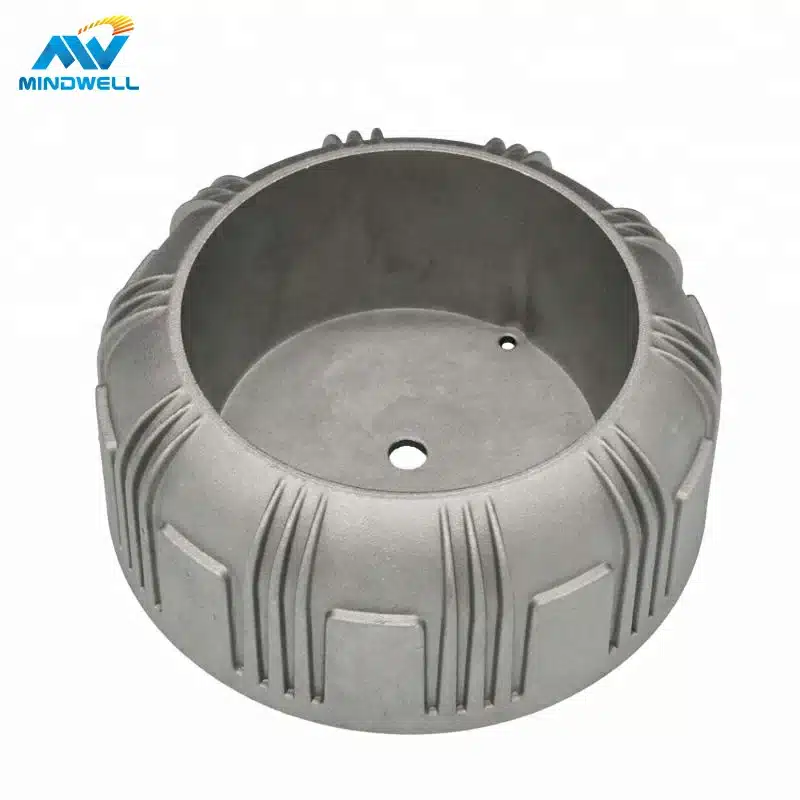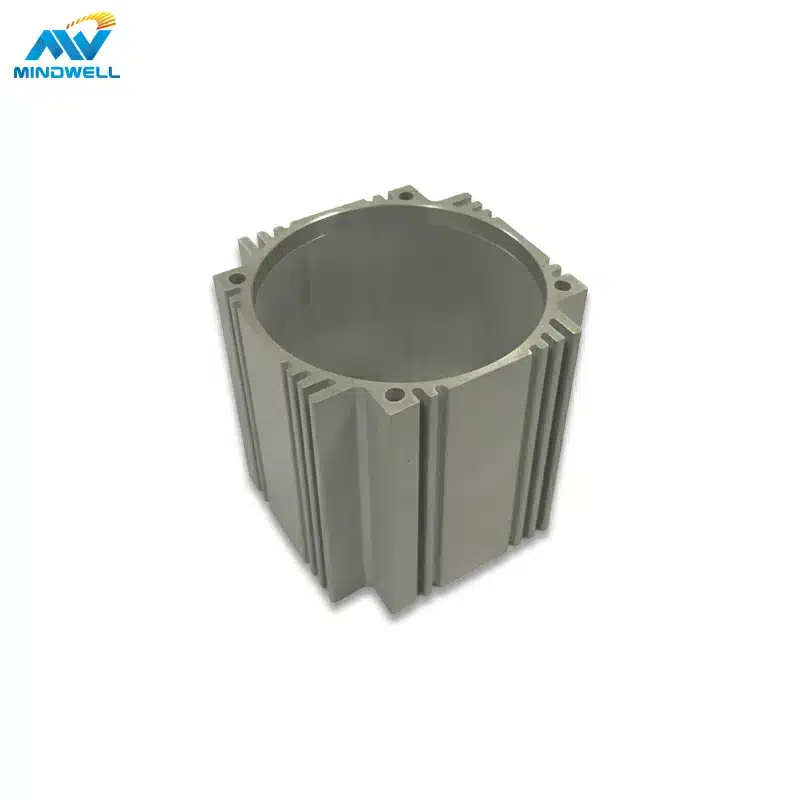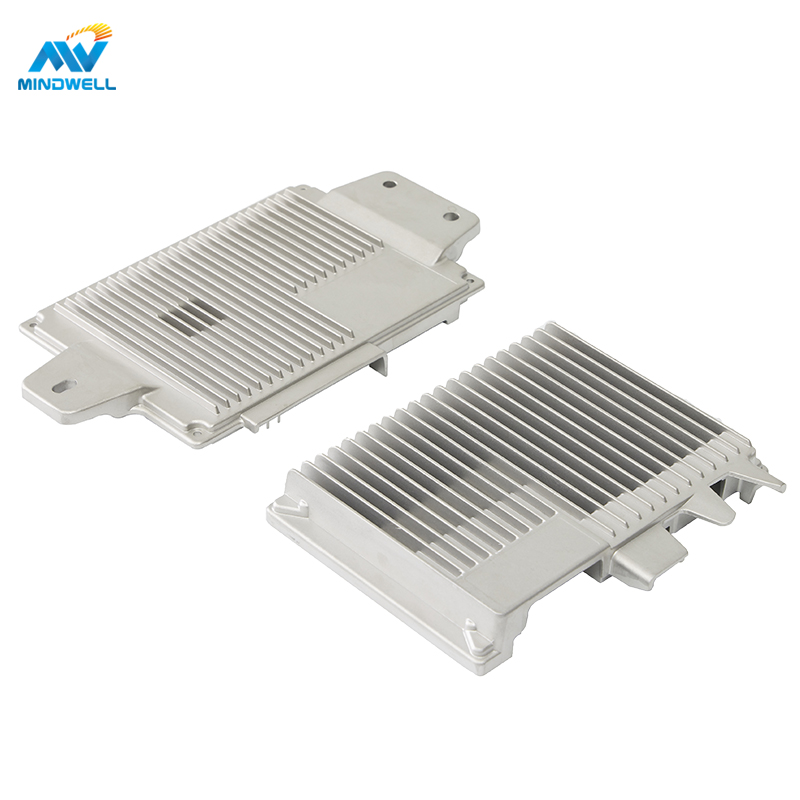Aluminium-Druckguss-Kühlkörper
Die von unserem Unternehmen entworfenen und angepassten Kühlkörper werden aus Aluminium hergestellt. Aluminium ist das am besten geeignete Material für Kühlkörper, da es eine hohe Härte und gute Wärmeableitungseigenschaften hat, die den Anwendungsanforderungen von Kühlkörpern entsprechen.
Bei Mindwell werden neben der Produktion und Herstellung von Aluminium-Druckgussteilekönnen wir auch Produktdesign und Formen anbieten. Unsere Designer entwerfen viele Löcher und Rippen je nach Anwendung des Kühlkörpers, um die Oberfläche zu vergrößern, oder verwenden wellenförmige Formen, um die Strömungsumlenkung zu verbessern. Kühlkörperanwendungen in verschiedenen Branchen, wie z. B. in der Automobilindustrie und bei LED-Leuchten, können je nach Bedarf angepasst werden. Nachfolgend werden wir die Informationen über Druckgusskühlkörper im Detail vorstellen.
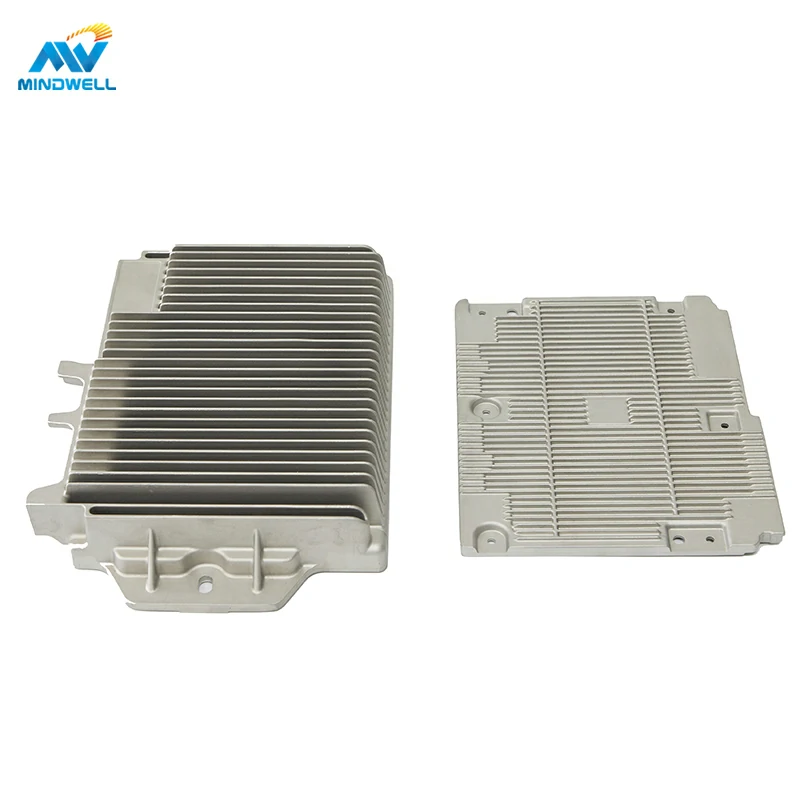
PRÄZISIONSHERSTELLER
Herstellungsprozess für druckgegossene Kühlkörper
Bei der Herstellung von Druckgusskühlkörpern wird eine Aluminium- oder Kupferlegierung geschmolzen und in eine Form gegossen. Anschließend wird die heiße Flüssigkeit unter Druck in die Form gegossen, um eine dreidimensionale Struktur mit mehreren Kühlkörpern zu bilden. Im Vergleich zu anderen Heizkörpern haben Aluminiumdruckguss-Heizkörper die Vorteile einer stabilen Struktur, einer hohen Festigkeit und einer hohen Wärmeableitungseffizienz.
Herstellungsverfahren für Kühlkörper aus Aluminiumdruckguss:
- Schmelzen von Aluminiumbarren
- Formenbau
- Form einbauen
- Druckguss
- Entformung
- Sekundäre Verarbeitung
- Paket

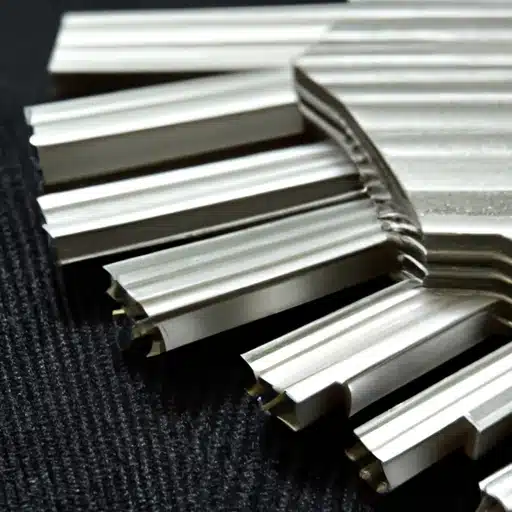
Materielle Vorteile
Kühlkörper Aluminium Material
Bei Mindwell verwenden wir hochwertige Aluminiumlegierungen zur Herstellung von Druckgusskühlkörpern. Das Aluminiummaterial selbst hat die Eigenschaften von guter Korrosionsbeständigkeit, hoher Festigkeit, geringem Gewicht usw. und verfügt über eine gute Wärmeleitfähigkeit und Wärmeableitungsleistung.
Bei Kühlkörpern können Form und Größe von Aluminiumkühlkörpern entsprechend den verschiedenen Anwendungsszenarien angepasst und verarbeitet werden.
Vorteile von Druckgusskühlkörpern
Die Verwendung von Druckgusskühlkörpern zur effektiven Kontrolle der von elektrischen Komponenten erzeugten Wärme hat mehrere Vorteile. Im Folgenden finden Sie eine Zusammenfassung der wichtigsten Vorteile, die Druckgusskühlkörper zu einer empfehlenswerten Option machen:
- Hohe Wärmeleitfähigkeit: Druckgusskühlkörper werden aus Materialien mit hervorragender Wärmeleitfähigkeit hergestellt, z. B. aus einer Aluminiumlegierung. Dies ermöglicht die schnelle Übertragung von Wärme auf den Kühlkörper, was die Wärme effektiv von den elektronischen Komponenten ableitet und zur Aufrechterhaltung einer optimalen Betriebstemperatur beiträgt.
- Komplexe geometrische Formen: Die inhärenten Verarbeitungseigenschaften von Aluminiumlegierungen in Verbindung mit dem Druckgussverfahren ermöglichen die Herstellung komplizierter geometrischer Formen. Diese Flexibilität verbessert den Luftstrom und die Oberfläche, wodurch die Gesamtleistung der Wärmeableitung von druckgegossenen Aluminiumkühlkörpern erhöht wird.
- Präzision und Gleichmäßigkeit: Druckguss ist eine präzise Fertigungstechnik, die eine zuverlässige Herstellung von Kühlkörpern garantiert. Die Aufrechterhaltung einer gleichmäßigen thermischen Leistung über ein breites Spektrum von Kühlkörpern hängt von dieser Konsistenz ab.
- Effiziente Serienproduktion: Das Druckgussverfahren erweist sich als wirtschaftliche Methode zur Herstellung von Kühlkörpern in großen Mengen. Es eignet sich aufgrund seiner effektiven und schnellen Produktionsmöglichkeiten, die letztlich die Stückkosten senken, für die Großserienfertigung.
- Ausgezeichnete Optionen für die Oberflächenbehandlung: Fertige Druckgusskühlkörper lassen sich leicht polieren, um ihr Aussehen zu verbessern und ihre Witterungsbeständigkeit zu erhöhen. Weitere Methoden zur Verbesserung der Korrosionsbeständigkeit sind Lackierung, Pulverbeschichtung und Eloxierung.
- Geringes Gewicht: Da Kühlkörper aus leichten Materialien (Aluminiumdruckguss und Zinklegierungen) hergestellt werden, eignen sie sich für Anwendungen, bei denen das Gewicht eine Rolle spielt (z. B. in der Automobil- oder Luftfahrtindustrie).
- Ausreichende elektrische Leitfähigkeit: Aluminium ist eines der Materialien, aus denen Kühlkörper hergestellt werden, und es hat eine hohe elektrische Leitfähigkeit. Anwendungen, die eine effiziente elektrische Erdung oder Leitfähigkeit erfordern, profitieren von dieser Eigenschaft.
- Beständigkeit und Langlebigkeit: Druckgussmaterialien wie Zink- und Aluminiumlegierungen sind für ihre Robustheit und Korrosionsbeständigkeit bekannt. Kühlkörper haben eine längere Lebensdauer, was zum Teil auf ihre Langlebigkeit zurückzuführen ist, die eine zuverlässige Leistung garantiert.
- Anpassungsmöglichkeiten: Der Druckguss ermöglicht die individuelle Anpassung von Kühlkörperdesigns an spezifische thermische Anforderungen. Ingenieure können das Rippendesign, die Größe und die Form ändern, um die spezifischen thermischen Anforderungen einer bestimmten Anwendung zu erfüllen.
Zusammenfassend lässt sich sagen, dass Druckgusskühlkörper Haltbarkeit, Kosteneffizienz, Designfreiheit und thermische Effizienz nahtlos miteinander verbinden. Aufgrund dieser Vorteile sind sie eine beliebte Option für verschiedene elektrische Geräte und Anwendungen, bei denen eine effiziente Wärmeregulierung wichtig ist.
Aluminium-Strangpressen VS-Druckguss-Kühlkörper
Strangpressen und Druckguss sind zwei unterschiedliche Herstellungsverfahren für Kühlkörper, die jeweils ihre eigenen Merkmale und Vorteile haben. Vergleichen wir Aluminiumstrangpressen und Druckgusskühlkörper:
Strangpress-Aluminium-Kühlkörper:
1. Herstellungsprozess:
- Verfahren: Beim Strangpressen wird Aluminium durch eine geformte Öffnung (Matrize) gepresst, um ein kontinuierliches Profil zu erzeugen. Das Profil wird dann auf die gewünschte Länge geschnitten.
- Flexibilität: Die Extrusion ermöglicht die Herstellung von langen, durchgehenden Profilen mit einem gleichmäßigen Querschnitt.
2. Flexibilität bei der Gestaltung:
- Kompliziertheit: Begrenzt im Vergleich zum Druckguss. Stranggepresste Kühlkörper sind in der Regel einfacher aufgebaut und weisen weniger komplizierte Merkmale auf.
- Personalisierung: Stranggepresste Profile können bis zu einem gewissen Grad individuell angepasst werden, aber die Möglichkeiten sind begrenzter.
3. Thermische Leistung:
- Wärmeleitfähigkeit: Gute Wärmeleitfähigkeit, aber nicht so hoch wie bei einigen Druckgussmaterialien.
Oberfläche: Effektiv zur Schaffung größerer Oberflächen für die Wärmeableitung.
4. Kosten:
- Produktionskosten: Die Extrusion ist im Allgemeinen ein kosteneffizientes Verfahren, insbesondere bei einfacheren Designs und kleineren Mengen.
- Werkzeugkosten: Die Werkzeugkosten sind im Vergleich zum Druckguss oft niedriger.
5. Oberflächengüte:
- Oberfläche: Stranggepresste Kühlkörper können im Vergleich zu druckgegossenen Kühlkörpern ein raueres Oberflächenfinish aufweisen.
- Oberflächenbehandlung: Zur Verbesserung der Ästhetik und Korrosionsbeständigkeit können Eloxal- oder andere Oberflächenbehandlungen durchgeführt werden.
Druckguß-Kühlkörper:
1. Herstellungsprozess:
- Verfahren: Beim Druckguss wird geschmolzenes Metall unter hohem Druck in einen Formhohlraum gespritzt. Mit diesem Verfahren lassen sich komplexe Formen mit feinen Details herstellen.
- Komplexität: gut geeignet für komplizierte und komplexe Designs mit feinen Details.
2. Flexibilität bei der Gestaltung:
- Komplexität: sehr flexibel. Druckguss ermöglicht komplizierte Rippen, variable Dicke und andere detaillierte Merkmale.
- Anpassungsmöglichkeiten: Es gibt mehr Optionen für die individuelle Anpassung, so dass es für eine breite Palette von Design-Anforderungen geeignet ist.
3. Thermische Leistung:
- Wärmeleitfähigkeit: Ausgezeichnete Wärmeleitfähigkeit, insbesondere bei Materialien wie Aluminium und Kupfer.
- Oberfläche: Kann für eine effiziente Wärmeableitung in kompakten Räumen optimiert werden.
4. Kosten:
- Produktionskosten: Druckguss kann bei großen Stückzahlen und komplexen Designs kostengünstig sein.
- Werkzeugkosten: Die anfänglichen Werkzeugkosten sind im Vergleich zum Strangpressen höher.
5. Oberflächengüte:
- Oberfläche: im Allgemeinen glattere Oberfläche als beim Strangpressen.
- Oberflächenbehandlung: Kann zur Verbesserung der Ästhetik, Korrosionsbeständigkeit und anderer funktioneller Eigenschaften behandelt werden.
Schlussfolgerung:
1. Überlegungen zur Anwendung:
- Die Extrusion eignet sich für einfachere Konstruktionen und wenn die Kosteneffizienz im Vordergrund steht.
- Druckguss ist ideal für komplexe Designs, hohe Stückzahlen und wenn die thermische Leistung entscheidend ist.
2. die Flexibilität bei der Gestaltung:
- Die Komplexität der Extrusion ist begrenzt.
- Der Druckguss bietet mehr Designflexibilität und komplizierte Details.
3.Kosten:
- Die Extrusion ist kostengünstig für einfachere Designs und kleinere Mengen.
- Druckguss kann bei großen Stückzahlen und komplexen Konstruktionen auf lange Sicht kostengünstig sein.
Letztendlich hängt die Entscheidung zwischen Aluminium-Strangpress- und Druckgusskühlkörpern von den spezifischen Anwendungsanforderungen, der Komplexität des Designs und dem Budget ab.
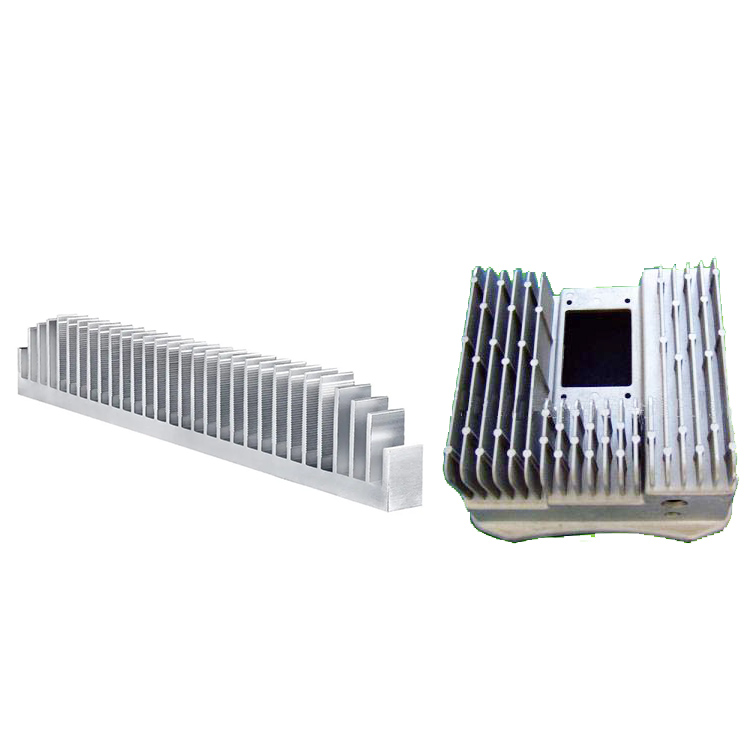
Beginnen Sie jetzt mit kundenspezifischen Druckgusskühlkörpern nach Ihren Bedürfnissen!
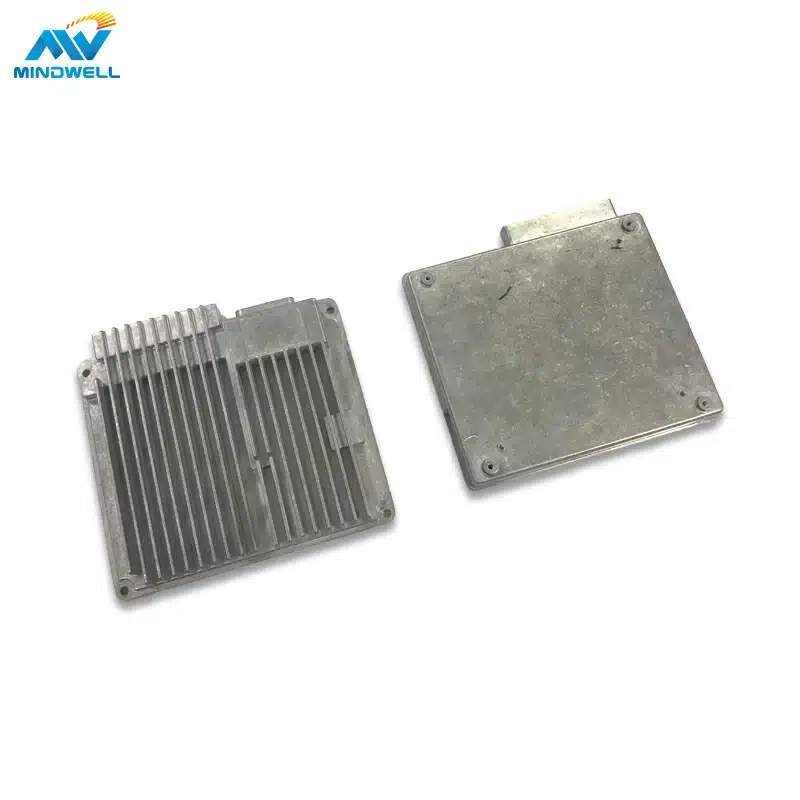
Aluminium-Kühlkörper Anwendungen
Kühlkörper aus Aluminiumdruckguss werden hauptsächlich dort eingesetzt, wo Wärme abgeleitet werden muss. Aufgrund des feinen Herstellungsverfahrens und des flexiblen Formdesigns können Kühlkörper in verschiedenen Formen und Größen entsprechend den unterschiedlichen Anforderungen hergestellt werden und haben eine breite Palette von Anwendungen. .
Aluminiumdruckguss-Kühlkörper werden hauptsächlich in elektronischen Geräten, Automotoren, LED-Leuchten und anderen Bereichen eingesetzt, die eine Wärmeableitung erfordern, und die Wärmeableitungswirkung ist sehr gut. Aufgrund des flexiblen Formdesigns und des feinen Herstellungsprozesses können Kühlkörper in verschiedenen Formen und Größen entsprechend den unterschiedlichen Anforderungen hergestellt werden, so dass sie eine breite Palette von Anwendungen haben.
Über US
Ein zuverlässiger Hersteller von Kühlkörper-Druckguss: Mindwell

Mindwell ist ein Unternehmen, das sich auf die Entwicklung und Herstellung von Druckgussteilen aus Aluminium- und Zinklegierungen sowie auf die Bearbeitung von Aluminiumprofilen spezialisiert hat. Es bietet eine umfassende Palette von Produktionsdienstleistungen an, die vom Entwurf und der Entwicklung von Formen bis hin zur Formgebung, Nachbearbeitung und Oberflächenbehandlung von Druckgussteilen reicht. Die Produkte werden hauptsächlich in elektronischen Geräten, Automobil- und Motorradzubehör, Möbeln und Badezimmern, Elektrowerkzeugen, medizinischen Geräten und anderen Branchen verwendet und nach Europa, Amerika und Südostasien exportiert.
Mindwell wurde im Jahr 2010 gegründet. Das Unternehmen verfügt über langjährige Erfahrung in den Bereichen Forschung und Entwicklung sowie Produktionsmanagement. Es nutzt Technologie und Management-Innovation als Mittel zur kontinuierlichen Verbesserung der Dienstleistungen und zur kontinuierlichen Senkung der Kosten, um Entwicklung zu suchen. Unabhängig von der Größe des Kunden, wird unser Unternehmen dies auch weiterhin tun. Wir bieten unseren Kunden Präzise Lösungen für den Druckgussprozessund arbeiten auch mit OEM und ODM zusammen.
Die Produktionswerkstatt des Unternehmens besteht aus einer Formenabteilung, einer Druckgussabteilung, einer Bearbeitungsabteilung, einer CNC-Abteilung usw., mit insgesamt 12 professionellen Formenbauingenieuren, Druckgusseinrichtern und CNC-Programmierern. Die Ausrüstung des Unternehmens ist vollständig. Die Formenabteilung ist mit verschiedenen Maschinentypen wie CNC, Präzisionsgravurmaschinen (CNC), CNC-Drehmaschinen, Drehbänken, Fräsmaschinen und Funkenmaschinen ausgestattet. Die Druckgussabteilung verfügt über Warm- und Kaltkammer-Druckgussmaschinen mit einer Kapazität von 800 Tonnen, 700 Tonnen, 500 Tonnen, 300 Tonnen, 280 Tonnen bzw. 160 Tonnen. Magnesium-, Aluminium- und Zinklegierungen können alle im Druckgussverfahren hergestellt werden. Außerdem gibt es CNC-Drehmaschinen. Die Nachbearbeitungsabteilung verfügt derzeit über verschiedene Ausrüstungen wie Bohrmaschinen, Gewindeschneidmaschinen, Schleifmaschinen, Poliermaschinen, Drahtziehmaschinen, Sandstrahlmaschinen, Walzmaschinen, Schleifmaschinen, Stanzmaschinen usw. Die Abteilung für Qualitätskontrolle ist mit einem dreidimensionalen Messgerät, einer Salzsprühnebelprüfmaschine, einem Vakuumdetektor, einem Waagendetektor und mehr als 100 weiteren Messgeräten ausgestattet.
Sofortiges Angebot anfordern
Fordern Sie noch heute Ihr kostenloses Angebot für das Spritzgießen an und wir werden uns mit Ihnen in Verbindung setzen.
Häufig gestellte Fragen
Mindwell bietet seit mehr als zehn Jahren Aluminium-Druckguss-Dienstleistungen in Xiamen an. Wir haben umfangreiche Erfahrung in der Anpassung von Druckguss-Kühlkörper-Entwicklern. Wenn Sie eine kundenspezifische Aluminium-Druckguss-Dienstleistung in Erwägung ziehen oder Fragen zum Aluminium-Druckguss haben, können Sie uns gerne kontaktieren. Sprechen Sie mit uns, kontaktieren Sie uns direkt und unsere Ingenieure werden mit Ihnen kommunizieren.
Aluminium-Kühlkörpergehäuse sind verschiedene Schalen aus einer Aluminiumlegierung. Sie sind hochflexibel und können auf jede beliebige Länge zugeschnitten werden. Die Bequemlichkeit ist unübertroffen von anderen Arten von Schalen. Und Aluminium ist ein Material mit guter Wärmeleitfähigkeit, so dass es eine sehr gute Wärmeableitung hat.
Auswahl des Aluminiummaterials für Kühlkörper
Auf dem heutigen Markt wird für Aluminiumgehäuse hauptsächlich eine Aluminiumlegierung verwendet. Aluminiumlegierungen haben eine gute Wärmeleitfähigkeit und sind robust und langlebig. Natürlich kann der Sockel aus einer Aluminiumlegierung Wärme besser aufnehmen und ableiten.
6063-Aluminiumprofil-Kühlkörpertechnologie:
Die Hersteller von Aluminiumprofilen entwickeln entsprechende Formen, um den Aluminiumbarren auf eine bestimmte Temperatur zu erhitzen und seine physikalische Form zu verändern, um Aluminiumkühlkörper zu erhalten.
Nachdem wir die Form verlassen haben, erhalten wir die verschiedenen Arten von Kühlkörperprofilen, die wir wünschen; dann können wir sie schneiden, nuten, polieren, entgraten, reinigen und mit einer Oberfläche versehen, bevor sie verwendet werden können.
Kühlkörper aus 6063-Aluminiumprofil:
Erstens: Der Kühlkörper aus 6063-Aluminiumprofil hat eine sehr hohe Wärmeleitfähigkeit
Aluminium hat eine hohe Wärmeleitfähigkeit und kann sehr gut zur Wärmeableitung bei elektronischen Produkten beitragen. Was das Aluminiumprofil-Kühlkörpermaterial betrifft, so ist die Wärmeleitfähigkeit der einzelnen Materialien unterschiedlich. Sie sind von hoch bis niedrig nach der Wärmeleitfähigkeit angeordnet. Unterschiede sind:
Kupfer, Aluminium, Stahl. Wenn jedoch Silber als Kühlkörper verwendet wird, ist es zu teuer, so dass die beste Lösung die Verwendung von Kupfer ist. Obwohl Aluminium viel billiger ist, ist seine Wärmeleitfähigkeit natürlich nicht so gut wie die von Kupfer (etwa 50% von der von Kupfer) ).
Die am häufigsten verwendeten Materialien für Aluminiumprofil-Kühlkörper sind Kupfer und Aluminiumlegierungen, die beide ihre eigenen Vor- und Nachteile haben. Kupfer hat eine gute Wärmeleitfähigkeit, ist aber teurer, schwer zu verarbeiten, übergewichtig, hat eine geringe Wärmekapazität und ist leicht oxidierbar.
Aluminium ist zu weich und kann nicht direkt verwendet werden. Nur die verwendete Aluminiumlegierung kann eine ausreichende Härte bieten. Die Vorteile der Aluminiumlegierung sind der niedrige Preis und das geringe Gewicht, aber ihre Wärmeleitfähigkeit ist viel schlechter als die von Kupfer. Einige Kühlkörper sind anders aufgebaut. Nehmen Sie die lange Antwort und betten Sie eine Kupferplatte in den Sockel des Kühlers aus Aluminiumlegierung ein. Dies kann nicht nur das Preisproblem lösen, sondern auch die Qualität der Wärmeableitung gewährleisten.
Zweitens: Die Dichte des 6063-Aluminiumprofilkühlkörpers ist geringer und lässt sich leichter zu anderen Teilen verarbeiten.
Einfache Installation und bequeme Wartung. Da die Aluminiumlegierung eine niedrige Dichte hat und in Teilen mit verschiedenen Formen und Spezifikationen hergestellt werden kann, ist der Querschnitt dieser Art von Aluminiumprofil-Heizkörpern groß und regelmäßig, und die Produktmontage und Oberflächenbehandlung kann in einem Schritt durchgeführt werden.
Die Stufen sind vor Ort und können direkt auf der Baustelle installiert werden, was hohe Installationskosten spart und die Wartung vereinfacht.
Drittens: 6063-Aluminium-Heizkörper hat starke Plastizität
Der 6063-Aluminium-Heizkörper kann verschiedenen Oberflächenbehandlungen unterzogen werden, mit vielen Farben und Varianten und ohne Lötstellen. Er ist sehr dekorativ, schön und langlebig und kann die individuellen Anforderungen der Menschen erfüllen. Yongyu Metal kann auch Sandstrahlen, Zeichnen und Polieren verarbeiten
Licht, Oberflächenanodisierung, Hartoxidation und andere Verarbeitungstechniken können schönere Aluminiumheizkörper erzeugen.
Heizkörper aus 6063-Aluminiumprofilen haben eine hohe Wärmeleitfähigkeit, eine geringe Dichte und einen niedrigen Preis, weshalb sie bei den großen Herstellern beliebt sind.
Weitere Funktionen des Kühlkörpers aus Aluminiumlegierung:
- Anti-elektromagnetische Strahlung: Die solide Hülle schützt die Platine, die Stromversorgung und die Speichergeräte und kann Druck, Stöße und Staub abhalten. Es kann auch die Funktion der Verhinderung von elektromagnetischen Störungen und Strahlung und Abschirmung von elektromagnetischer Strahlung durchführen.
- Geringe Dichte: Die Dichte der Schale aus Aluminiumlegierung ist sehr gering. Der Behälter ist leicht herzustellen und kann als Handyschale und Ladeschale verwendet werden. Er ist außerdem sehr verschleißfest und korrosionsbeständig. Ein dichter Aluminiumoxidfilm bildet sich leicht auf der Oberfläche der Aluminiumlegierung, um das Wachstum von Nährstoffen zu verhindern.
- Speichergeräte: Es bietet Platz für Netzteile, Hauptplatinen, verschiedene Erweiterungsplatinen, Diskettenlaufwerke, optische Laufwerke, Festplattenlaufwerke und andere Speichergeräte, die durch Stützen, Halterungen, verschiedene Schrauben oder Clips im Inneren des Gehäuses verbunden sind. Die Komponenten befestigen diese Teile sicher innerhalb des Gehäuses, um ein intensives Ganzes zu bilden.
- Hohe Festigkeit: Die Schale aus Aluminiumlegierung kann die Härte der Aluminiumschale nach der Alterungsbehandlung effektiv verbessern. Das Aluminiumprofil Schale nach rauen Oberflächenbehandlung berücksichtigt nicht nur die Wärmeableitung Leistung, sondern berücksichtigt auch das Aussehen.
- Geringes Gewicht. Nur ein Drittel des Gewichts eines Gussheizkörpers bei gleicher Wärmeabgabe. Geringes Gewicht, leicht zu installieren und zu transportieren. Bei gleicher Wärmeabgabe beträgt das Gewicht nur ein Zehntel eines gusseisernen Heizkörpers, ein Sechstel eines Stahlheizkörpers und ein Drittel eines Kupferheizkörpers, wodurch Transportkosten, Arbeitsaufwand und Installationszeit eingespart werden können.
- Sicher und zuverlässig. Sicher und zuverlässig, hohe thermische Effizienz, gute Wärmeleitfähigkeit, energiesparend und umweltfreundlich, lange Lebensdauer.
- Korrosionsbeständigkeit. Die Oberfläche des Kühlkörpers aus Aluminiumdruckguss wird entfettet, oxidiert und dann sprühbeschichtet, um sicherzustellen, dass die Beschichtung lange Zeit nicht abfällt und schlagfest ist. Auf der Oberfläche von Aluminiumlegierungen kann sich eine dicke Oxidschicht bilden, die für die Erwärmung von Wasser mit einem pH-Wert ≤ 9 oder für den langfristigen Einsatz in Wassertanks von Kraftfahrzeugen verwendet werden kann. Aluminiumkühlkörper mit spezieller Oberflächenbehandlung können bei verschiedenen pH-Werten bis 12 eingesetzt werden. Dieses Material wird lange Zeit verwendet.
- Schön. Der Kühlkörper aus Aluminiumdruckguss hat ein einfaches, schönes, elegantes und dennoch modisches Design, ist klein, leicht und einfach zu installieren und übernimmt die hervorragende europäische Kühlerproduktionstechnologie. Die Kühlrippen sind in einer Vielzahl von Oberflächenausführungen erhältlich. Es hat eine Vielzahl von Mustern und Farben, keine Lötstellen, starke Dekoration, schön und langlebig, und kann die persönlichen Anforderungen der Menschen zu erfüllen.
- Breite Anwendung. Weit verbreitet in Automobilen, LED, etc., mechanischen Geräten, elektronischen Geräten, Motorgehäuse und anderen Industrien.
- Die Abmessungen sind variabel. Schönes Aussehen, flexible Größe. Es kann eine künstlerische Form sein, oder es kann nach den besonderen Anforderungen der speziellen Räume und Benutzer angepasst werden, um Ihre Persönlichkeit zu zeigen; es ist einfach zu passen und mit dem Raum zu koordinieren, so dass es ein perfektes Heimdekoration Produkt.
- Hohe Festigkeit. Heizkörper aus Aluminiumdruckguss haben eine hohe Gesamtfestigkeit und einen hohen Betriebsdruck und sind daher für Hochhäuser geeignet, da die spezifische Festigkeit und die spezifische Steifigkeit von Aluminiumlegierungen viel höher sind als die von Kupfer, Gusseisen und Stahl. Obwohl sie dünn sind, halten sie ausreichend Druck, Biege-, Zug- und Stoßkräften stand und werden bei der Handhabung, Installation und Nutzung nicht beschädigt.
- Einfach zu installieren. Modulkombination, einfach zu installieren. Aufgrund der geringen Dichte der Aluminiumlegierung kann sie zu Teilen mit verschiedenen Formen und Spezifikationen verarbeitet werden. Diese Art von Aluminiumheizkörpern hat einen großen und regelmäßigen Querschnitt. Die Produktmontage und Oberflächenbehandlung kann in einem Schritt erfolgen. Er kann direkt auf der Baustelle installiert werden, was eine Menge Installationskosten spart. Auch die Wartung ist sehr bequem und kostengünstig.
- Energieeinsparung und Verbrauchsreduzierung, niedrige Betriebskosten. Wenn der Mittenabstand des Heizkörpereinlasses und -auslasses gleich der Wärmeleitungstemperatur ist, ist der Aluminiumheizkörper 2,5 mal mehr gestreut als der Gussheizkörper, und kann wegen seines schönen Aussehens nicht beheizt werden. Er kann den Wärmeverlust um mehr als 30 Zoll reduzieren und die Kosten um 10 Zoll senken. Obwohl die Kühlwirkung des oben genannten Aluminiumheizkörpers nicht ganz so gut ist wie die des Kupferheizkörpers, kann das Gewicht stark reduziert werden. Da der Preis von Aluminium nur 1/3 des Preises von Kupfer beträgt, können die Kosten erheblich gesenkt werden.
Kühlkörper aus Aluminiumdruckguss werden häufig in Automotoren, elektronischen Geräten, Industriemaschinen und anderen Bereichen eingesetzt. Der Kühler eines Automotors beispielsweise benötigt Aluminiumdruckgusslamellen zur Wärmeableitung, um den normalen Betrieb des Motors zu gewährleisten.
Der Herstellungsprozess von Aluminium-Druckguss-Kühlkörpern umfasst hauptsächlich die folgenden Schritte:
- - Entwerfen Sie die Struktur von Kühlkörpern, bestimmen Sie Materialien und Spezifikationen;
- - Kühlkörperform herstellen;
- - Schmelzen Sie das Material aus der Aluminiumlegierung und drücken Sie es mit einer Druckgussmaschine in die Form des Kühlkörpers, lassen Sie es abkühlen und aushärten;
- - Oberflächenbehandlung von Kühlkörpern aus Aluminiumdruckguss, wie Oxidationsbehandlung, Lackierung usw.
- - Produktqualität: MindWell (im Folgenden MNW genannt) führt eine strenge Qualitätskontrolle der Produkte durch und ist ein zuverlässiger Lieferant von Aluminiumdruckgusskühlkörpern;
- - Unterstützungsdienst: MNW hat einen guten Kundendienst und technischen Support und kann Probleme für Kunden rechtzeitig lösen;
- - Kostenkontrolle: Wir bieten Ihnen angemessene Produktpreise und Vorzugspreise, um die Kosten wirksam zu kontrollieren;
- - Innovationsfähigkeit: Das Unternehmen verfügt über langjährige Produktionserfahrung und ein Ingenieurteam sowie über Forschungs- und Entwicklungskapazitäten, die den Kunden neuartige und wettbewerbsfähige Kühlkörperprodukte bieten können.
Bei der Wartung und Instandhaltung von Kühlkörpern aus Aluminiumdruckguss sind vor allem die folgenden Punkte zu beachten:
- - Überprüfen Sie regelmäßig den Betriebszustand und die thermische Effizienz des Heizkörpers und tauschen Sie den Heizkörper rechtzeitig aus;
- - Reinigen Sie den Kühler, um seine Kühlwirkung zu gewährleisten; Sie können dazu professionelle Reinigungswerkzeuge verwenden;
- - Prüfen Sie regelmäßig, ob die Montage und die Halterung des Heizkörpers locker sind oder abfallen;
- - Vermeiden Sie die Verwendung des Heizkörpers bei hohen Temperaturen, in feuchter oder staubiger Umgebung.
Bei der Konstruktion eines Aluminium-Druckguss-Kühlkörpers berücksichtigen Ingenieure in der Regel die folgenden Aspekte: Gehäusegröße, Wärmeabgabeleistung, Lüfterkonfiguration und Installationsmethode.
- Die Gehäusegröße ist sehr wichtig. Sie muss auf der Grundlage der Größe und Anzahl der Kühlelemente bestimmt werden. Die Größe des Gehäuses wirkt sich direkt auf die Kühlleistung des Heizkörpers aus. Ist es zu klein, führt es zu einer unzureichenden Wärmeabgabe, ist es zu groß, führt es zu Material- und Kostenverschwendung.
- Die Wärmeabgabeleistung ist ein wichtiges Kriterium für Kühlkörper aus Aluminiumdruckguß. Die Höhe der Wärmeableitungsleistung steht in engem Zusammenhang mit der Wärmeableitungsleistung der internen Wärmeableitungskomponenten und dem Betriebszustand des Lüfters. Daher muss bei der Konstruktion des Gehäuses auf ausreichend Platz für die Wärmeableitung und einen ausreichenden Luftstrom geachtet werden, um den Wärmeableitungseffekt zu gewährleisten.
- Die Lüfterkonfiguration ist ein weiterer wichtiger Faktor, der bei der Konstruktion eines Aluminiumdruckgusskühlkörpers zu berücksichtigen ist. Es muss sichergestellt werden, dass die Luft durch den gesamten Kühler strömen kann, wobei die Geräuschentwicklung und der Stromverbrauch zu berücksichtigen sind.
- Die Installationsmethode ist der letzte wichtige Faktor bei der Konstruktion von Aluminiumdruckgusskühlkörpern. Unterschiedliche Installationsmethoden wirken sich auf die Wärmeableitung und die Zweckmäßigkeit des Kühlers aus. Durch die Wahl der richtigen Installationsmethode kann der Heizkörper stabiler und zuverlässiger im Betrieb sein, und kann auch bequemer gewartet und ersetzt werden.
Kurz gesagt, der Kühlkörper aus Aluminiumdruckguss ist eines der wichtigsten Teile des Kühlers, und sein Design spielt eine sehr wichtige Rolle für die Leistung und Zweckmäßigkeit des Kühlers. Durch ein angemessenes Größendesign, die Berechnung der Kühlleistung, die Lüfterkonfiguration und ausgezeichnete Installationsmethoden können den Benutzern effizientere, sichere und zuverlässige Kühllösungen geboten werden.


